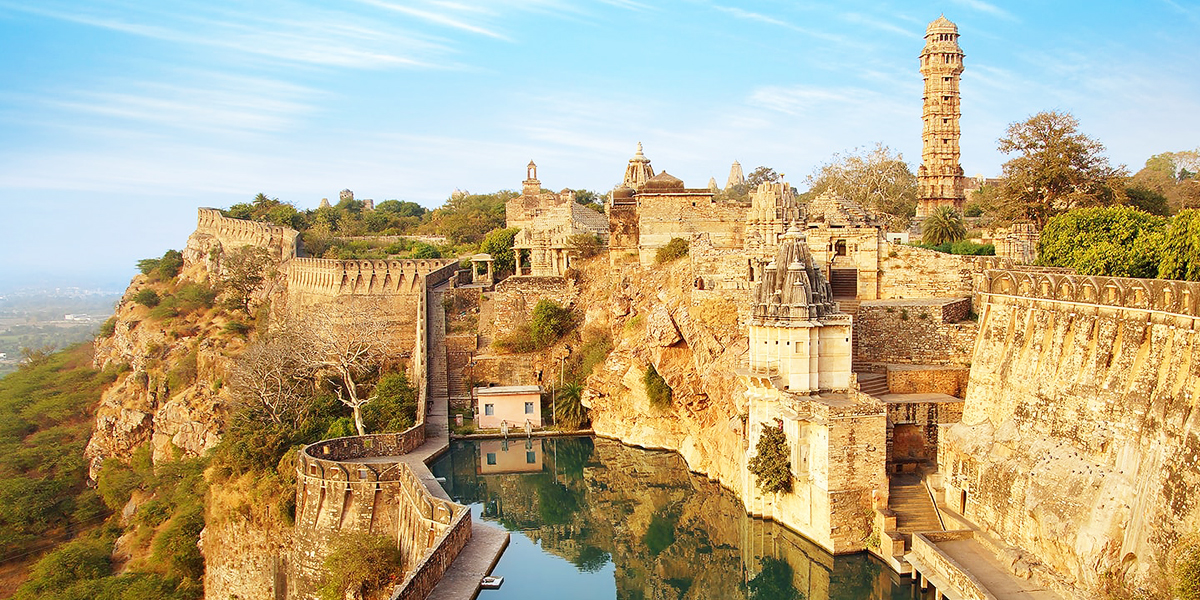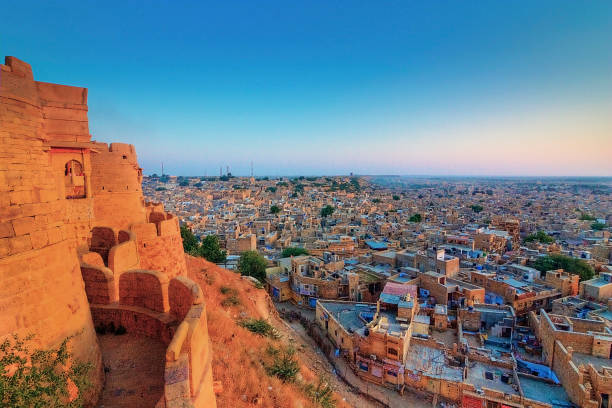Located in South-Eastern Rajasthan, Chittorgarh is known for Chittorgarh Fort, the largest fort in India built on a hilltop, spreading over an area of around 700 acres. The capital of the erstwhile kingdom of Mewar, the magnificent fortress will always be remembered for the courageous self-sacrificing Jauhar performed by Rani Padmini to thwart the conquest of the fort by Alauddin Khilji. The most famous attraction in Chittorgarh fort is the Padmini Palace, named after Queen Padmini herself. Replete with roof pavilions and water moats, the story of Queen Padmini’s valour rings out loud in every corner of this dilapidated building.
WEATHER
TRAVEL SEASONS |
MIN/MAX TEMPERATURE |
SEASON |
October - March |
10°C - 25°C |
|
July - September |
20°C - 30°C |
Monsoon Season - Unexpected Downpours |
April - July |
36°C - 48°C |
Summer Season - Hot |
AVERAGE MONTHLY RAINFALL |
Month |
Jan |
Feb |
Mar |
Apr |
May |
Jun |
Jul |
Aug |
Sep |
Oct |
Nov |
Dec |
Rainfall (mm) |
4.5 |
5.7 |
3.5 |
3.8 |
10.1 |
56.8 |
175.8 |
181.4 |
75.5 |
14.9 |
3.4 |
2.4 |
BEST TIME TO VISIT
Winters are the best time to visit Chittorgarh. From the months of October and March, one can easily partake in sightseeing without any hassle. Moreover, since the weather remains pleasant, therefore, you will not have to worry about the scorching heat. Best of all, you will stare clear of rains as well.
CUISINE
Chittorgarh's cuisine has little that standouts but a number of local roadside eating places as well as restaurants can be found here. Though the town has little to call unique, when it comes to food, but you will never run out of options here. You can find a number of food domains here, from Mughal cuisine, local Rajasthani food to typical vegetarian Indian food.
SHOPPING
Sadar bazaar is one of those popular street markets in Chittorgarh where you will find a huge variety of fancy Rajasthani items and products. It is vibrant, crowded and full of life. Shop for some of the famous items such as fabrics, camel leather products, metal wares, jewellery, toys and so on. Dress materials are available in various types of fabrics such as vegetable dyes and heavy threadwork. There are metal wares which also remain a common favourite among buyers here. Also, check out the colorful and lovely camel leather 'jutis'. Intricate embroidered works make these unique Rajasthani items extremely beautiful and attractive.
Rana Sanga Market - Rana Sanga Market in Chittorgarh is another popular place for a lovely shopping experience. Out of the several things available in the entire state of Rajasthan, Chittorgarh’s Rana Sanga Market is a major hub for selling the most exquisite Rajasthani items. Out of the huge variety of items available at its shops, some of the popular products worth buying are jewellery, metal wares, fabrics, wooden toys and Rajasthani handicrafts. The metal wares are bought by many tourists as souvenirs or memento. The beautiful fabric works are made attractive with vegetable dyes and are sold like hot cakes in the market.
LANGUAGE
Hindi is the official language of Chittorgarh but languages like English, Mewari, and Rajasthani are spoken as well.
THINGS TO DO
1. SOUND AND LIGHT SHOW OF CHITTORGARH FORT
After exploring the fort, do not just leave the spot. Stay back for the sound and light show, which starts by 7 in the evening. This sound and light show explains the history of the land, chivalry of royal families and the growth of the region.
2. BIRD WATCHING AT BASSI WILDLIFE SANCTUARY
If you love bird watching or wildlife photography, you ought to visit Bassi wildlife sanctuary, early in the morning during winter season. Numerous migration and local birds are commonly found in this region. Certain bird species are commonly spotted during sunset only.
3. CAVE EXPLORATION
Drive to Menal, outside Chittorgarh to explore the caves of ancient temples and Buddhist religious sites. You can also enjoy water activities, picnic and other outdoor entertainments in Menal.
4. PANORAMIC VIEW FROM KIRTI STAMBH
Climb up the 30 feet tower to the top floor to get a panoramic view of Chittorgarh City. It is located inside the fort complex of Chittorgarh.
5. A TOUR TO THE SANWARIYA JI TEMPLES
People can also visit the Sanwariya Ji Temple which is dedicated to Lord Krishna. The temple is located just a few kilomteres from the main city of Chittorgarh and located in Bhadsoda Chouraha and one can see the idols of Lord Krishna in this temple.
The idols are seen in complete black stone and decorated with golden jewellery and Lord Krishna is seeing playing flute which makes it an adoring view of the idols and people in huge numbers visit this temple on the occasion of Janmasthami that comes in the month Bhadra that commonly fall in the months of August-September.
6. WALKING TO THE CHITTORGARH SHOPPING ALLEYS
Chittorgarh shopping experience is equally famous alike its fort and other Chittorgarh activities and that is why it will be a nice and thrilling trip to the local shopping markets of Chittorgarh where you can buy for the various articles such as Camel leather products, traditional Rajasthan articles such as bangles, miniature paintings, wooden handicrafts, stunning figures made of marble, jewellery.
The most important is the Thewa jewellery is a unique one which can be bought from here and the specialty of this jewelry is that the gold designs are set in in glass and the main markets of Chittorgarh are Sadar bazar, Fort Road Market and.
PLACES TO VISIT
1. CHITTORGARH FORT
Built by local Maurya rulers (often confused with imperial Maurya Rulers) in 7th century A.D, the Chittorgarh Fort in Rajasthan is one of the largest forts in India. The Chittorgarh Fort, plainly known as Chittor is spread majestically over a hill of 590 feet in height and is spread across 692 acres of land is a fine example of the popular Rajput architecture. The imposing structure of the fort has many gateways built by the later rulers of the Maurya clan. Chittorgarh Fort was previously the capital of Mewar and is now situated in the city of Chittorgarh. Chittorgarh Fort reverberates with tales of heroism and sacrifice and displays the Rajput culture and values in the real sense. Owing to its magnificent edifice, the Chittorgarh Fort was declared a UNESCO's World Heritage Site in the year 2013.
2. RANI PADMINI'S PALACE
This palace plays an important role in Rajput history. The structure is built on the banks of a lotus pool and has a pavilion that provides privacy for the women of the royal family. Ala-ud-din Khilji, then Sultan of Delhi, spotted Queen Padmini’s reflection in the pool and was so besotted by her beauty that he led his forces in battle to abduct her.
3. VIJAY STAMBH
Vijay Stambh (the Tower of Victory) was built by Maharana Kumbha between 1440 AD and 1448 AD to immortalise his triumph of defeating the Muslim rulers of Malwa and Gujarat. Built partly from red sandstone and partly white marble, this architectural wonder is nine-storey tower decorated with detailed sculptures of Hindu gods and goddesses. Narrow steps lead to the terrace where one can catch a spectacular view of the entire town from the balconies.
4. KIRTI STAMBH
This Tower of Fame is dedicated to Adinathji, the 1st Jain Tirthankara (great teacher). Adorned by the figures of the Digambars (Jain monks), this seven-storied tower was built by a wealthy Jain merchant in 12th century AD.
5. JAIN TEMPLES
The fort of Chittor has six Jain temples contained within its walls. The largest among them is the temple of Bhagawan Adinatha which has 52 ‘devkulikas’.
6. FATEH PRAKASH PALACE
Constructed by Maharana Fateh Singh, this palace functioned as his residence. It was built in the Rajput style of architecture as a declaration of his taste for art and culture. The palace has a vast collection of wood crafts of Bassi village, post medieval statues of Jain Ambica and Indra from Rashmi village, weapons such as axes, knives and ancient shields, clay replicas of regional tribal people clad in their traditional costumes, paintings, and crystal ware. It has now been converted into a museum.
7. KALIKA MATA TEMPLE
Built in 8th century AD, this ancient structure was initially constructed to worship the sun god. In the 14th century, the temple was dedicated to Goddess Kali, the symbol of power and valour.
8. GAU MUKH KUND
Located within Chittorgarh fort, the Gomukh Kund is also known as "Tirth Raj'' of Chittorgarh because whenever pilgrims and devotees go on the tour of different Hindu spiritual places, then they come to Gomukh kund for completion of their holy journey after returning back.
Gau Mukh literally means mouth of cow and it has been named so because the water flows from the cow mouth shaped point. Natural environment with lush green plants and flowing water is what makes this place even more attractive.
9. ARCHAEOLOGICAL MUSEUM
Archaeological Museum of Chittorgarh displays a valuable collection of artefacts belonging to the royalty of Chittorgarh. Located inside the Chittorgarh Fort, on the eastern end of the Banbir Ki Diwar, it is visited quite often by history and archaeology enthusiasts. The museum houses many artefacts from the Chittor Fort along with some ancient relics belonging to the Hindu and Buddhist Religions excavated a few years ago. Right from the entrance, the Archaeological Museum is bound to take one back to the past. The paintings, sculptures, apparels, weapons, coins, frescos, inscriptions and other metal and terracotta figures give a glimpse into the regal lifestyle of the Rajputs. The mighty Chittor Fort is a preferred spot for picnickers and visitors never miss the Archaeological Museum once they are here.
10. MENAL TEMPLE & WATERFALL
80 kilometrs from Bhilwara, on the Bhilwara-Kota road is a beautiful waterfall where the water falls to a depth of 150 metres into a V-shaped valley with great force, making for a beautiful sight. People from all corners of the State flock to take it in. The best time to visit the Menal Waterfall is from July to October.
11. MEERA TEMPLE
Meera Temple or Meera Bai Temple located in the premises of Chittorgarh Fort is dedicated to Meera Bai who was a Rajput Princess. The striking temple was constructed by Maharana Kumbha, the Rajput king during his rule, making it both a historical and religious attraction. As soon as one enters the place of worship, they are bound to feel immense tranquillity and happiness. The divine vibe of the temple is unexplainable but touches every soul offering their prayers here. Visitors choose to sit quietly, meditate and reflect upon their life goals often here and many find a direction in life. As one explores the scintillating site, they will notice the intricate carvings on the walls and the pillars that add to the ethnic charm of the monument. These carvings depict stories about Meera Bai, Lord Krishna and their sacrifices for each other.
12. SANWARIAJI TEMPLE
Sanwariaji Temple is dedicated to Lord Krishna and is located in Mandaphia in the North-Western Indian state of Rajasthan. Mandaphia is about 40 kilometres away from the city of Chittorgarh and falls on the Chittorgarh-Udaipur Highway. Because of its location, devotees visit the temple in large numbers while commuting between Chittorgarh and Udaipur. The resplendent temple complex is a beautiful work of architecture and adorns colourful paintings and carvings that tourists find quite mesmerizing. The deity is also known as Shri Sanwariaji Seth and is believed to be of immense importance for merchants and traders who offer their prayers to gain success and wealth in their businesses. Stories about striking gold from nowhere all because of the blessings of the deity are usually heard in the region. It, therefore, ranks second on the list of religiously important temples dedicated to Lord Krishna for the Hindu community.


